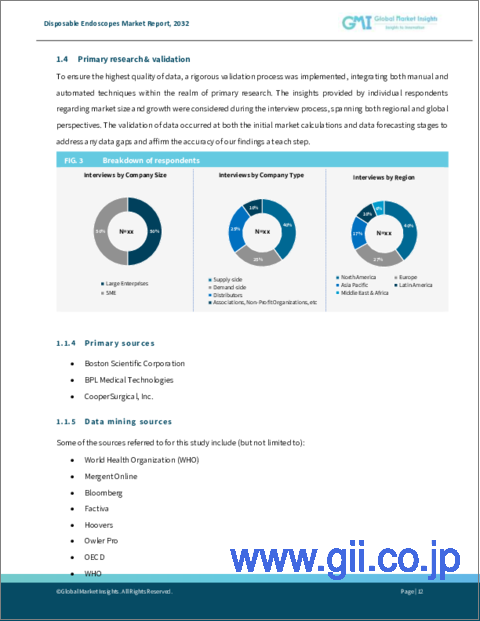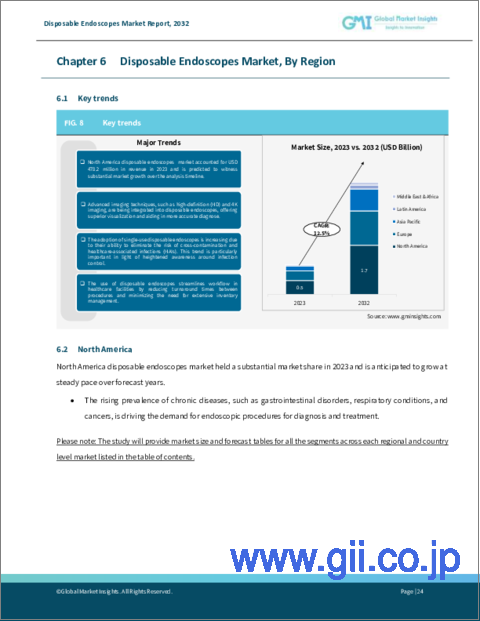|
|
市場調査レポート
商品コード
1544814
使い捨て内視鏡市場、市場機会、成長促進要因、産業動向分析と予測、2024-2032年Disposable Endoscopes Market, Opportunity, Growth Drivers, Industry Trend Analysis and Forecast, 2024-2032 |
||||||
カスタマイズ可能
|
|||||||
| 使い捨て内視鏡市場、市場機会、成長促進要因、産業動向分析と予測、2024-2032年 |
|
出版日: 2024年07月04日
発行: Global Market Insights Inc.
ページ情報: 英文 105 Pages
納期: 2~3営業日
|
- 全表示
- 概要
- 目次
使い捨て内視鏡の世界市場規模は、2024年から2032年の間にCAGR 14.1%で拡大すると予測され、患者の安全性と利便性の向上に焦点を当てるとともに、高度なイメージングやコードレス設計などの使い捨て内視鏡技術の革新が後押しします。
これらの進歩は、感染制御や使いやすさのような重要な問題に対処し、従来の再利用可能な機器と比較して、より信頼性が高く衛生的なソリューションを提供します。ヘルスケアプロバイダーが患者の安全性と業務効率をますます優先するようになるにつれ、最先端技術と利便性・安全性の向上を兼ね備えた使い捨て内視鏡への需要が高まり、市場の拡大に拍車がかかると思われます。
例えば、2022年11月、Integrated Endoscopy社は、関節鏡手術における従来の再利用可能な関節鏡の限界を克服するために設計された、バッテリー駆動、コードレス、シングルユースの第2世代NUVIS関節鏡を発表しました。この開発は、使い捨て内視鏡への需要の高まりに対応する革新的でユーザーフレンドリーなソリューションへの動向を浮き彫りにしています。これは、先進的、衛生的、効率的な内視鏡技術への市場のシフトを反映しており、さらなる採用と成長を促進しています。
使い捨て内視鏡産業は、製品、用途、患者タイプ、エンドユーザー、地域によって細分化されています。
十二指腸内視鏡は、特に十二指腸の診断や治療など、消化管処置において重要な役割を果たすことから、2032年までに大幅な成長が見込まれます。消化器疾患の有病率の上昇と内視鏡処置における感染管理の必要性が、使い捨て十二指腸内視鏡の需要を促進しています。使い捨てのデザインは、交差汚染のリスクを大幅に最小化し、患者の安全性を向上させるため、これらのデバイスはヘルスケア環境で好まれる選択肢となっています。感染予防と処置の効率化がこのセグメントの優位性を支えています。
気管支鏡セグメントは、呼吸器疾患の有病率の増加や感染管理の重視の高まりにより、2032年までにかなりの足場を築くと思われます。使い捨て気管支鏡は、呼吸器疾患の管理に不可欠な患者間の二次汚染を防ぐという重要な利点を提供します。使い捨ての設計は高い衛生水準を保証し、院内感染のリスクを低減するため、臨床現場で高く評価されています。このように患者の安全性と効率性を重視することが、気管支鏡セグメントの大幅な成長の原動力となっています。
欧州は、高度なヘルスケアインフラ、厳格な規制基準、革新的医療技術の高い採用率に後押しされ、2024年から2032年にかけて著しい成長率を記録します。同地域では、感染対策と患者の安全性が重視されているため、交差汚染のリスクを低減し、処置効率を向上させる使い捨て内視鏡の需要が高まっています。さらに、欧州の確立されたヘルスケアシステムと大手医療機器メーカーの強力なプレゼンスは、世界の使い捨て内視鏡市場への主要な貢献者となっています。
目次
第1章 調査手法と調査範囲
第2章 エグゼクティブサマリー
第3章 業界洞察
- エコシステム分析
- 業界への影響要因
- 促進要因
- 胃腸疾患、がん、その他の慢性疾患の増加
- 低侵襲処置に対する需要の増加
- 使い捨て内視鏡の技術的進歩
- 汚染と感染対策への関心の高まり
- 業界の潜在的リスク&課題
- 新興諸国における熟練した医師や内視鏡医の不足
- 促進要因
- 成長可能性分析
- 規制状況
- 償還スキーム
- 技術的展望
- 今後の市場動向
- 価格分析
- パイプライン分析
- ギャップ分析
- ポーター分析
- PESTEL分析
第4章 競合情勢
- イントロダクション
- 企業マトリックス分析
- 企業シェア分析
- 競合ポジショニングマトリックス
- 戦略ダッシュボード
第5章 市場推計・予測:製品タイプ別、2021年~2032年
- 主要動向
- 気管支鏡
- 膀胱鏡
- 十二指腸内視鏡
- 子宮鏡検査
- 喉頭鏡
- 尿管鏡
- その他の製品タイプ
第6章 市場推計・予測:用途別、2021年~2032年
- 主要動向
- 消化器内視鏡
- 耳鼻咽喉科内視鏡
- 気管支鏡
- 泌尿器科
- 産科/婦人科
- その他の用途
第7章 市場推計・予測:患者タイプ別、2021年~2032年
- 主要動向
- 成人
- 小児
第8章 市場推計・予測:エンドユーザー別、2021年~2032年
- 主要動向
- 病院
- 外来手術センター
- その他のエンドユーザー
第9章 市場推計・予測:地域別、2021年~2032年
- 主要動向
- 北米
- 米国
- カナダ
- 欧州
- ドイツ
- 英国
- フランス
- イタリア
- スペイン
- オランダ
- その他欧州
- アジア太平洋
- 中国
- 日本
- インド
- オーストラリア
- 韓国
- その他アジア太平洋地域
- ラテンアメリカ
- ブラジル
- メキシコ
- アルゼンチン
- その他ラテンアメリカ
- 中東・アフリカ
- サウジアラビア
- 南アフリカ
- アラブ首長国連邦
- その他中東とアフリカ
第10章 企業プロファイル
- Ambu A/S
- Baxter International
- Boston Scientific Corporation
- BPL Medical Technologies
- CooperSurgical, Inc.
- Flexicare Medical Ltd.
- HOYA Corporation
- KARL STORZ
- OBP Medical Corporation
- Olympus Corporation
- Parburch Medical Developments Ltd
- Pentax Medical Company
- Richard Wolf Gmbh
- Shenzhen HugeMed Medical Technical Development Co., Ltd.
- Tonglu General Factory of Medical Optical Instruments
Global Disposable Endoscopes Market size will expand at a 14.1% CAGR between 2024 and 2032, fueled by innovations in disposable endoscope technology, such as advanced imaging and cordless designs, along with a focus on enhancing patient safety and convenience. These advancements address critical issues like infection control and ease of use, offering more reliable and hygienic solutions compared to traditional reusable devices. As healthcare providers increasingly prioritize patient safety and operational efficiency, the demand for disposable endoscopes that combine cutting-edge technology with enhanced convenience and safety will grow, fueling market expansion.
For instance, in November 2022, Integrated Endoscopy introduced the second-generation NUVIS arthroscope, a battery-operated, cordless, single-use device designed to overcome the limitations of conventional reusable arthroscopes in arthroscopic surgeries. The development highlights a trend toward innovative, user-friendly solutions that cater to the growing demand for disposable endoscopes. It reflects the market's shift towards advanced, hygienic, and efficient endoscopic technologies, driving further adoption and growth.
The disposable endoscopes industry is fragmented based on product, application, patient type, end-use, and region.
The duodenoscopes segment will experience a substantial surge by 2032, attributed to their critical role in gastrointestinal procedures, particularly for diagnosing and treating conditions in the duodenum. The rising prevalence of gastrointestinal diseases and the need for infection control in endoscopic procedures drive demand for disposable duodenoscopes. Their single-use design greatly minimizes the risk of cross-contamination and improves patient safety, making these devices a favored option in healthcare environments. The focus on infection prevention and procedural efficiency supports the dominance of this segment.
The bronchoscopy segment will achieve a considerable foothold by 2032, owing to the increasing prevalence of respiratory diseases and the growing emphasis on infection control. Disposable bronchoscopes offer a critical advantage in preventing cross-contamination between patients, which is essential in managing respiratory conditions. Their single-use design ensures high hygiene standards and reduces the risk of nosocomial infections, making them highly valued in clinical settings. This focus on patient safety and efficiency drives the substantial growth of the bronchoscopy segment.
Europe will record a remarkable growth rate from 2024 to 2032, propelled by its advanced healthcare infrastructure, stringent regulatory standards, and high adoption rates of innovative medical technologies. The region's emphasis on infection control and patient safety drives the demand for disposable endoscopes, which reduce the risk of cross-contamination and improve procedural efficiency. Additionally, Europe's well-established healthcare systems and strong presence of leading medical device manufacturers make it a primary contributor to the global disposable endoscopes market.
Table of Contents
Chapter 1 Methodology and Scope
- 1.1 Market scope and definitions
- 1.2 Research design
- 1.2.1 Research approach
- 1.2.2 Data collection methods
- 1.3 Base estimates and calculations
- 1.3.1 Base year calculation
- 1.3.2 Key trends for market estimation
- 1.4 Forecast model
- 1.5 Primary research and validation
- 1.5.1 Primary sources
- 1.5.2 Data mining sources
Chapter 2 Executive Summary
- 2.1 Industry 360°synopsis
Chapter 3 Industry Insights
- 3.1 Industry ecosystem analysis
- 3.2 Industry impact forces
- 3.2.1 Growth drivers
- 3.2.1.1 Rising incidences of gastrointestinal disorders, cancer and other chronic conditions
- 3.2.1.2 Increasing demand for minimally invasive procedures
- 3.2.1.3 Technological advancements in disposable endoscopes
- 3.2.1.4 Increased focus on contamination and infection control
- 3.2.2 Industry pitfalls and challenges
- 3.2.2.1 Dearth of skilled physicians and endoscopists in developing countries
- 3.2.1 Growth drivers
- 3.3 Growth potential analysis
- 3.4 Regulatory landscape
- 3.5 Reimbursment scenerio
- 3.6 Technological landscape
- 3.7 Future market trends
- 3.8 Pricing analysis
- 3.9 Pipeline analysis
- 3.10 Gap analysis
- 3.11 Porter's analysis
- 3.12 PESTEL analysis
Chapter 4 Competitive Landscape, 2023
- 4.1 Introduction
- 4.2 Company matrix analysis
- 4.3 Company share analysis
- 4.4 Competitive positioning matrix
- 4.5 Strategy dashboard
Chapter 5 Market Estimates and Forecast, By Product Type, 2021 - 2032 ($ Mn)
- 5.1 Key trends
- 5.2 Bronchoscopes
- 5.3 Cystoscopes
- 5.4 Duodenoscopes
- 5.5 Hysteroscopes
- 5.6 Laryngoscopes
- 5.7 Ureteroscopes
- 5.8 Other product types
Chapter 6 Market Estimates and Forecast, By Application, 2021 - 2032 ($ Mn)
- 6.1 Key trends
- 6.2 GI endoscopy
- 6.3 ENT endoscopy
- 6.4 Bronchoscopy
- 6.5 Urology
- 6.6 Obstetrics/gynecology
- 6.7 Other applications
Chapter 7 Market Estimates and Forecast, By Patient Type, 2021 - 2032 ($ Mn)
- 7.1 Key trends
- 7.2 Adult
- 7.3 Pediatric
Chapter 8 Market Estimates and Forecast, By End-Use, 2021 - 2032 ($ Mn)
- 8.1 Key trends
- 8.2 Hospitals
- 8.3 Ambulatory surgical centers
- 8.4 Other end-users
Chapter 9 Market Estimates and Forecast, By Region, 2021 - 2032 ($ Mn)
- 9.1 Key trends
- 9.2 North America
- 9.2.1 U.S.
- 9.2.2 Canada
- 9.3 Europe
- 9.3.1 Germany
- 9.3.2 UK
- 9.3.3 France
- 9.3.4 Italy
- 9.3.5 Spain
- 9.3.6 Netherlands
- 9.3.7 Rest of Europe
- 9.4 Asia Pacific
- 9.4.1 China
- 9.4.2 Japan
- 9.4.3 India
- 9.4.4 Australia
- 9.4.5 South Korea
- 9.4.6 Rest of Asia Pacific
- 9.5 Latin America
- 9.5.1 Brazil
- 9.5.2 Mexico
- 9.5.3 Argentina
- 9.5.4 Rest of Latin America
- 9.6 Middle East and Africa
- 9.6.1 Saudi Arabia
- 9.6.2 South Africa
- 9.6.3 UAE
- 9.6.4 Rest of Middle East and Africa
Chapter 10 Company Profiles
- 10.1 Ambu A/S
- 10.2 Baxter International
- 10.3 Boston Scientific Corporation
- 10.4 BPL Medical Technologies
- 10.5 CooperSurgical, Inc.
- 10.6 Flexicare Medical Ltd.
- 10.7 HOYA Corporation
- 10.8 KARL STORZ
- 10.9 OBP Medical Corporation
- 10.10 Olympus Corporation
- 10.11 Parburch Medical Developments Ltd
- 10.12 Pentax Medical Company
- 10.13 Richard Wolf Gmbh
- 10.14 Shenzhen HugeMed Medical Technical Development Co., Ltd.
- 10.15 Tonglu General Factory of Medical Optical Instruments






